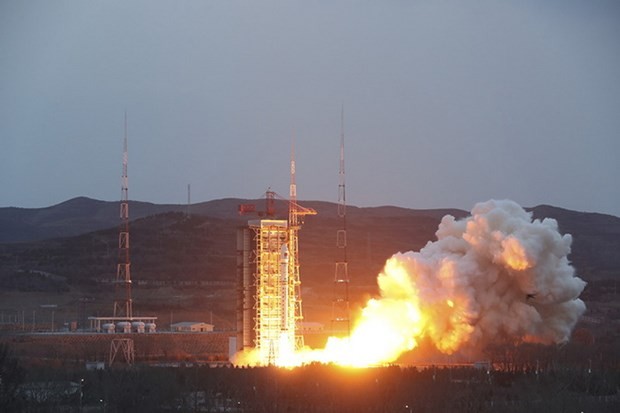 |
| A Long March-2D rocket carrying the PIESAT-1 satellite constellation was launched from the Taiyuan Satellite Launch Center in northern China's Shanxi Province on March 30. (Source: Xinhua) |
The PIESAT-1 satellite constellation was launched at 18:50 Beijing time (ie 17:50 Vietnam time) from the Taiyuan Satellite Launch Center in Shanxi province, northern China, and then entered the planned orbit.
It has a wheel-like structure consisting of a main satellite rotating around a central axis and three secondary satellites evenly spaced in an elliptical "wheel" and revolving around the main satellite. These secondary satellites are a few hundred meters away from the main satellite.
PIESAT-1 is able to maintain space stability and safety thanks to precise orbit control through inter-satellite links and phase synchronization links. The four satellites in the PIESAT-1 constellation are equipped with interferometric synthetic aperture radars (InSAR) - an effective tool for measuring changes on the ground.
InSAR takes two images at different times using radar signals reflected from the target area on Earth, then interferes with them to create maps called interferograms, which show the displacement on the ground between the two time periods.
Compared with traditional InSAR, the wheel-shaped PIESAT satellite constellation can generate more interferometric baselines, thus increasing the mapping efficiency.
PIESAT-1 is mainly used to provide commercial remote sensing data services, capable of conducting fast and efficient global land surveying. It can perform mm-level deformation monitoring to determine the status of land subsidence and landslides, thereby achieving early detection of major geological disasters.
It is known that PIESAT-1 was designed by the satellite manufacturing company Galaxy Space Beijing Network Technology and managed by PIESAT - a satellite operation and application service provider in China.
The Long March 2D rocket is a two-stage rocket with a take-off thrust of 300 tons. This is the 469th flight of the Long March rocket.
 | India successfully launched a rocket carrying 36 communication satellites, joining the 'race' to provide high-speed Internet services. On March 26, the Indian Space Research Organization launched a heavy-lift rocket LVM3 carrying 36 OneWeb communication satellites... |
 | Angola gets its first satellite operations center Angola continues to invest in telecommunications with more satellites and infrastructure to ensure that the sector ... |
 | Russia develops super-awesome laser reconnaissance complex Russia has developed a state-of-the-art reconnaissance system capable of detecting and identifying a person at a distance of 18km... |
 | Clearview facial recognition technology supports US police Facial recognition company Clearview has performed nearly a million searches for US police forces, a representative said... |
 | Paper batteries and the dream of reducing electronic waste A Singaporean student is developing a paper battery for electronic devices that could replace ... |
Source






![[Photo] Cat Ba - Green island paradise](/_next/image?url=https%3A%2F%2Fvphoto.vietnam.vn%2Fthumb%2F1200x675%2Fvietnam%2Fresource%2FIMAGE%2F2025%2F12%2F04%2F1764821844074_ndo_br_1-dcbthienduongxanh638-jpg.webp&w=3840&q=75)































































































Comment (0)